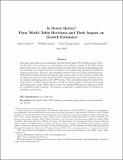| dc.contributor.author | Johnson, Simon | |
| dc.contributor.author | Larson, William | |
| dc.contributor.author | Papageorgiou, Chris | |
| dc.contributor.author | Subramanian, Arvind | |
| dc.date.accessioned | 2014-06-11T16:33:33Z | |
| dc.date.available | 2014-06-11T16:33:33Z | |
| dc.date.issued | 2013-03 | |
| dc.date.submitted | 2010-06 | |
| dc.identifier.issn | 03043932 | |
| dc.identifier.uri | http://hdl.handle.net/1721.1/87736 | |
| dc.description.abstract | This paper sheds light on two problems in the Penn World Table (PWT) GDP estimates. First, we show that these estimates vary substantially across different versions of the PWT despite being derived from very similar underlying data and using almost identical methodologies; that the methodology deployed to estimate growth rates leads to systematic variability, which is greater: at higher data frequencies, for smaller countries, and the farther the estimate from the benchmark year. Moreover, this variability matters for the cross-country growth literature. While growth studies that use low frequency data remain robust to data revisions, studies that use annual data are less robust. Second, the PWT methodology leads to GDP estimates that are not valued at purchasing power parity (PPP) prices. This is surprising because the raison d’être of the PWT is to adjust national estimates of GDP by valuing output at common international (purchasing power parity [PPP]) prices so that the resulting PPP-adjusted estimates of GDP are comparable across countries. We propose an approach to address these two problems of variability and valuation. | en_US |
| dc.language.iso | en_US | |
| dc.publisher | Elsevier B.V. | en_US |
| dc.relation.isversionof | http://dx.doi.org/10.1016/j.jmoneco.2012.10.022 | en_US |
| dc.rights | Creative Commons Attribution-Noncommercial-Share Alike | en_US |
| dc.rights.uri | http://creativecommons.org/licenses/by-nc-sa/4.0/ | en_US |
| dc.source | MIT web domain | en_US |
| dc.title | Is newer better? Penn World Table Revisions and their impact on growth estimates | en_US |
| dc.type | Article | en_US |
| dc.identifier.citation | Johnson, Simon, William Larson, Chris Papageorgiou, and Arvind Subramanian. “Is Newer Better? Penn World Table Revisions and Their Impact on Growth Estimates.” Journal of Monetary Economics 60, no. 2 (March 2013): 255–274. | en_US |
| dc.contributor.department | Sloan School of Management | en_US |
| dc.contributor.mitauthor | Johnson, Simon | en_US |
| dc.relation.journal | Journal of Monetary Economics | en_US |
| dc.eprint.version | Author's final manuscript | en_US |
| dc.type.uri | http://purl.org/eprint/type/JournalArticle | en_US |
| eprint.status | http://purl.org/eprint/status/PeerReviewed | en_US |
| dspace.orderedauthors | Johnson, Simon; Larson, William; Papageorgiou, Chris; Subramanian, Arvind | en_US |
| dc.identifier.orcid | https://orcid.org/0000-0002-3354-7155 | |
| mit.license | OPEN_ACCESS_POLICY | en_US |
| mit.metadata.status | Complete | |
